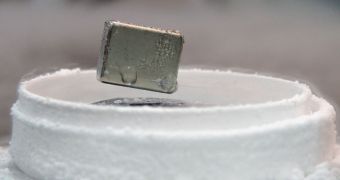Look no further than Earth! You won't find lower temperatures on any other body in the universe. For example, the Moon experiences about -227 degrees Celsius, while the vacuum temperature is approximated at about -265 degrees. However, on Earth, humans have been capable of cooling material to even lower temperatures, while studying the behavior of matter in such extreme conditions. At ultracold temperatures materials, atoms and even light start presenting weird interactions.
The first experiment of this kind was conducted in the beginning of the 20th century by physicists studying the electrical behavior of mercury at extremely low temperatures. At -262 degrees Celsius, they observed the superconductivity phenomenon, meaning the the electrical resistance of the cooled material was close to zero. Further experiments at lower temperatures eventually revealed the superfluidity property of materials, substances being capable of oozing through solid walls or crawling out of their containers.
Absolute zero is calculated to be about -273.15 degrees Celsius, but the physicists always knew that such temperatures could never be reached. Practically, the temperature represents a good approximation of the energy contained inside an object, thus at zero Kelvin a body cannot radiate any heat through any known process, because all of it has been extracted.
Nevertheless, physical experiments are always trying to push the lowest temperature limit closer and closer to absolute zero. For example, the lowest temperature ever achieved was recored in 2003 at Wolfgang Ketterle's laboratory from the Massachusetts Institute of Technology, and was only 810 trillionths of a Fahrenheit degree above absolute zero. The extreme temperature was accomplished while working with a cloud of sodium molecules, held in place by powerful magnetic fields.
One might wonder what would be the driving force behind these kinds of experiments. That's simple, Bose-Einstein condensates, a state of matter that is neither gas, liquid or solid, but they are observed in the form of clouds of atoms, each having the same quantum state. Such forms of matter were predicted in 1925 by Albert Einstein and Indian physicist Satyendra Bose, only to be created seven decades later. One of the physicists that showed that BECs exist was Ketterle, which eventually received the Nobel prize for his work.
One of the advantages of using BECs is the fact that they make possible an easier manipulation of light. In void, light travels with a speed of about 300,000 kilometers per second. It is the maximum speed in the universe, thus nothing is allowed to travel faster than light. However, this is not always true. For example, light traveling through the mass of a substance has a lower speed than that traveling through vacuum.
Bose-Einstein condensates are able to slow light to speeds close to that of a bicycle, and it is predicted that it could even stop the light. Due to the temperature and the density of BEC, the light slows down and could eventually be captured and converted directly into electric current, transferred into a second BEC and converted back into light to be released in the surrounding medium. This feature is extremely important for telecommunication and supercomputing devices.
Ketterle argues that experiments at ultracold temperatures should continue in order to get a better understanding of the thermodynamics laws governing the universe. The physicists' goal is still the absolute zero, although they understand that extracting every bit of energy out of an atom is basically impossible.

 14 DAY TRIAL //
14 DAY TRIAL //